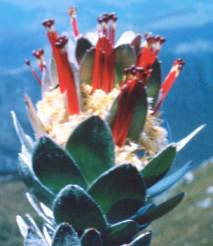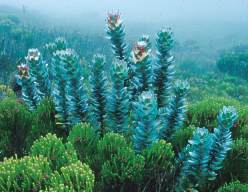Mimetes hottentoticus
Mimetes hottentoticus E.Phillips & Hutch.
Family: Proteaceae
Common names: silver pagoda, Hottentotstompie (Afr.)
Introduction
This is a beautiful shrub with silvery leaves and distinctive flowers. Mimetes can be easily distinguished from all other Proteaceae. The beauty and brilliance of their flowerheads, which are displayed at the end of long, flowering branches, places Mimetes among the most handsome and strikingly beautiful of all proteas.

Description
Description
Mimetes hottentoticus is a single-stemmed, erect shrub attaining a height of 3 m. The loosely overlapping, oval leaves are silvery and silky in texture. The flowers are arranged in between the leaves at the ends of the branches. These 'floral leaves' surrounding the flowers are oblong in shape and display a silvery pink colour, making them brilliantly luminescent. The 60-70 mm long styles are the outstanding feature of this species. They are brilliant red with a touch of yellowish white just below the black pollen presenters, which form a decorative 4 mm head. These prominent, match-like styles on a silver Mimetes are so unique that the species can never be confused with any other member of the genus. Mimetes hottentoticus flowers from January to May (late summer to autumn), but peaks mainly in February.

Conservation Status
Status
Rare.
Initiatives towards survival
Ex situ conservation: Mimetes hottentoticus can be grafted onto hardy rootstock and kept in collections at botanical gardens, however the species is relatively short-lived and survival is dependent on constant monitoring by experienced horticulturists. Our experience is that this only works in the short term and it is not a viable conservation solution. Storage of seeds in the Millenium Seed Banks at Wisley is a much more viable option.
In situ conservation: Protection of the natural habitat is by far the best way to ensure survival. This includes good field management practices and limited access to the sensitive environment where this plant grows. In this respect the Cape Nature Conservation Board is doing a good job. Particular care should be taken to prevent over-burning of the habitat, which will result in the depletion of the seedbank and ultimately in the loss of this beautiful species.
Distribution and habitat
Distribution description
Mimetes hottentoticus grows on very high, steep, damp, southern slopes of the Kogelberg, ranging from 1 000-1 260 m above sea level. The area is subject to high rainfall over 2 000 mm a year, and this moisture is augmented by regular envelopment in cool clouds rising from the sea.The southeast cloud that regularly envelops the Kogelberg and the altitude play an important role in cooling the habitat during the summer months.The species has a very restricted habitat. It is confined to an area of just over 5 km2 on the Kogelberg Reserve, which is about 75 km southeast of Cape Town.

This species is known from only three populations, with the largest population of plants on the upper southeast slopes of Kogelberg Peak.
Derivation of name and historical aspects
History
Mimetes derives its name from a Greek word meaning 'to imitate'. This probably refers to the leaves, which in size, shape, and arrangement are remarkably like those of some species of other genera such as Leucospermum. For example, the ends of the leaves of Leucospermum are toothed, which is noticeable in five Mimetes species.
Thomas Pearson Stokoe (1868-1959), legendary mountaineer and plant collector at the Cape, first encountered this species in its natural habitat in November 1921. He subsequently returned to the locality and collected flowering specimens at the end of February 1922. Specimens were sent to Dr. E. P. Phillips at the National Herbarium in Pretoria. This new discovery from the Kogelberg became known as Mimetes hottentoticus, named after the Hottentots Holland Mountains near where it occurs.

Ecology
Ecology
The plants grow in nutrient poor, acidic, sandy soils derived from quartzitic rock. The plants are pollinated by long-tailed sugarbirds. The nut-like seeds are released 2-6 months after flowering. The seeds include a fleshy lump at the base of the nut called an elaiosome, which is a rich food source that attracts indigenous ants. The ants drag the fruits into their nests where the seeds are safely housed until fire clears the competing vegetation. The heat of the fire combined with the removal of covering vegetation and addition of moisture stimulate the seeds to germinate.
Growing Mimetes hottentoticus
Grow
Mimetes hottentoticus, like most Proteaceae is relatively short-lived. The plant's life span rarely exceeds thirty years. It has proved to be difficult to grow, as it is susceptible to various root-affecting fungal diseases such as phytophthora. In 1977 Phillip van der Merwe of the Cape Department of Nature Conservation pioneered a technique of grafting this species onto Leucospermum conocarpodendron rootstock. This pincushion displays the degree of hardiness needed to protect the plant from diseases in the soil.
Grafting Mimetes
The technique is simple. There are a number of different types of grafts, but the preferred one is called the cleft graft because it provides a strong union between the rootstock and the top part of the plant called the scion. The cleft graft involves choosing a healthy rootstock with a stem approximately 15 mm in diameter and the wood still green. A fresh young shoot is selected from the plant to be grafted. The shoot should be either the same diameter as the rootstock or may be a bit thinner.
Equipment required is sharp clean scalpels, grafting or budding tape (plastic), a broad-spectrum fungicide and wax or tree sealer. The top of the rootstock plant is removed with one clean cut. A single sharp vertical incision, about 30 mm is made into the top of the cut surface of the rootstock. The cut surfaces are washed with fungicide. A fresh, sturdy shoot approximately 60-100 mm long is cut from the Mimetes plant and the basal leaves are removed. The stem is pared on either side with single clean slices producing a tapering wedge. This is inserted into the vertical cut and firmly bound in position using the tape. Tree sealer or wax is used to seal the cracks at the union to prevent water from penetrating the graft and causing disease. A clear plastic bag is placed over the graft to keep the humidity levels higher and prevent desiccation. Hoops of wire support the plastic bag. The plant is then placed in a protected position under cover. The area should not be too warm, but the light conditions must be good.
The grafts must be closely monitored over the next few weeks. The union between the rootstock and scion will take a number of weeks, but a successful graft should be evident in three months. The plastic is slit and slowly removed to allow the graft to adapt to its surroundings.
It is important that the rootstock is chosen from a disease-resistant species and also a plant that assumes the same proportions as the plant to be grafted onto it. If a large Protea such as M. hottentotticus is grafted onto a smaller protea it will outgrow the rootstock in diameter at the union, become too heavy, and the top part of the plant will fall over.
The plant grows best in containers and when provided with light shade in summer. This is probably because Mimetes hottentoticus grows in cooler conditions at a relatively high altitude and also receives the fresh sea breezes during the summer.
Dr. Louis Vogelvoel has been one of the successful cultivators of this species in his garden in Rondebosch. He has rooted cuttings at his home and has displayed container grown specimens at Cape flower shows.
References
- REBELO, A.G. (Tony). 1995. Sasol Proteas. A field guide to the proteas of southern Africa. Fernwood Press, Cape Town.
- ROURKE, J.P. & LINCOLN, T. 1982. Mimetes. An illustrated account of Mimetes Salisb. and Orothamnus Pappe, two notable Cape genera of the Proteaceae. Tiyan, Cape Town.
- ROURKE, J.P. 1984. A revision of the genus Mimetes Salisb. (Proteaceae) Journal of South African Botany 50: 171-236.
- VOGTS, M. 1982. South Africa's Proteaceae. Know them and grow them. Struik, Cape Town.
Credits
Anthony Hitchcock
Kirstenbosch National Botanical Garden
November 2002
Plant Attributes:
Plant Type: Shrub
SA Distribution: Western Cape
Soil type: Sandy
Flowering season: Late Summer
PH: Acid
Flower colour: Red, Cream
Aspect: Full Sun
Gardening skill: Challenging
Special Features:
Horticultural zones







Rate this article
Article well written and informative
Rate this plant
Is this an interesting plant?
Login to add your Comment
Back to topNot registered yet? Click here to register.